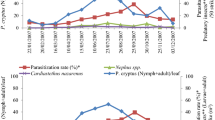Abstract
The present study was carried out in southern Greece during 1993-1995 on sour orange trees infested with the diaspididParlatoria pergandii Comstock. The activity of the natural enemies of the scale, the composition of their population during the year as well as their relation with hymenopterous parasitoids of coccinellids, were studied.P. pergandii was parasitized by a hymenopterous endoparasite of the genusEncarsia and the extent of parasitization ranged between 5.2% and 14.1%. The observed predators were the coccinelidsChilocoms bipustulatus Linnaeus andRhyzobius lophanthae Blaisdell and the nitidulidCybocephalus fodori Endrödy-Younga. The predominant predator wasR. lophanthae (84.3% of the larvae and 73.3% of the adults), which was active throughout the whole year in all of its developmental stages. Second most abundant was the predatorC. bipustulatus (15.7% of the larvae and 20% of the adults) and third the predator C.fodori (6.7% of the adults). Larvae ofC. bipustulatus were observed to be parasitized by the hymenopterous parasitoidsHomalotylus flaminius Dalman (Encyrtidae) andTetrastichus coccinellae Kurdjumov (Eulophidae). The parasitization percentage increased gradually from 4% in mid June to 94% around the end of September. Laboratory tests confirmed that the above mentioned parasitoids cannot infest larvae or nymphs ofR. lophanthae.
Similar content being viewed by others
References
Abbassi, M. (1975) Notes bio-écologiques surParlatoria pergandei Comstock [sic] (Homopt. Coccidae) au Maroc.Fruits 30:179–184.
Applebaum, S.W., Kfir, R., Gerson, U. and Tadmor, U. (1971) Studies on the summer decline ofChilocorus bipustulatus in citrus groves of Israel.Entomophaga 16:433–444.
Argyriou, L.C. and Katsoyannos, P. (1977) Coccinellidae species found in the olive-groves of Greece.Ann. Inst. Phytopathol Benaki (N.S.) 11:331–345.
Bodenheimer, F.S. (1951) Citrus Entomology in the Middle East. W. Junk, the Hague, the Netherlands.
Dent, D.R. and Walton, M.P. (1997) Methods in Ecological and Agricultural Entomology. University Press, Cambridge, UK.
Domenichini, G. (1956) Contribute alla conoscenza dei parassiti e iperparassiti dei Coleoptera Coccinellidae.Boll. Zool. Agrar. Bachic. Milano 22:215–246.
Hodek, I. (1973) Biology of Coccinellidae. W. Junk, the Hague, the Netherlands.
Hodek, I. and Honěk, A. (1996) Ecology of Coccinellidae. Kluwer Academic Publishers, Dordrecht, the Netherlands.
Katsoyannos, P. (1984) Notes on life history and field efficiency ofCybocephalus fodori predator ofQuadraspidiotus perniciosus in northern Greece.Entomol. Hell. 2:35–40.
Murashevskaya, Z.S. (1969) Species ofChilocorus.Zashch. Rast. 14:36–38.
Podoler, H. and Henen, J. (1983) A comparative study of the effects of constant temperatures on development time and survival of two coccinellid beetles of the genusChilocorus.Phytoparasitica 11:167–176.
Popova, A.I. (1971)Chilocorus in the control of the California scale.Zashch. Rust. 16:42–43.
Rosen, D. (1990) Armored Scale Insects: Their Biology, Natural Enemies and Control. Elsevier, Amsterdam, the Netherlands.
Rubstov, I.A. (1952)Lindorus —an effective predator of Diaspine scales.Entomol. Obozr. 32:96–106.
SAS (1989) JMP—A Guide to Statistical and Data Analysis. Version 3. SAS Institute Inc., Cary, NC, USA.
Smirnoff, W. (1950) Sur la biologie au Maroc deRhyz.obius (Lindoms) lophanthae Blaisd. (Col.Coccinallidae).Rev. Pathol. Veg. Entomol. Agric. Fr. 29:190–194.
Smirnoff, W.A. (1957) La cochenille du palmier—dattier(Parlatoria blanchardi Targ.) en Afrique du Nord. Comportement, importance économique, prédateurs, et lutte biologique.Entomophaga 2:1–98.
Stathas, G.J. (2000) The effect of temperature on the development of the predatorRhyz.obius lophanthae Blaisdell (Coleoptera: Coccinellidae) and its phenology in Greece.BioControl 45:439–451.
Yinon, U. (1969) The natural enemies of the armored scale lady-beetleChilocorus bipustulatus (Col.: Coccinellidae).Entomophaga 14:321–328.
Author information
Authors and Affiliations
Rights and permissions
About this article
Cite this article
Stathas, G.J. Ecological data on predators ofParlatoria pergandii on sour orange trees in southern Greece. Phytoparasitica 29, 207–214 (2001). https://doi.org/10.1007/BF02983452
Received:
Revised:
Issue Date:
DOI: https://doi.org/10.1007/BF02983452




